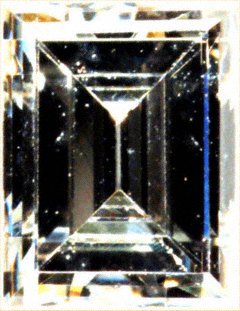| The Very Highest Quality Diamond Information... |
| Baguette Diamonds |

|
|
|
Trap or Step Cut
Rectangular shaped stones are usually cut in steps, and are known as step or trap cut. The baguette cut is an oblong or rectangular step or trap cut. This was a simple cut used by the earliest jewellers for many gemstones including emeralds and diamonds, because it is relatively easy to cut, especially with the limited tools and technology available until recently. Better, more brilliant cuts were only discovered in the second quarter of the twentieth century.
It is our strongly held opinion that more modern cuts such as princess, and more particularly radiant cuts produce far more attractive diamonds than older cuts such as the step cut, and therefore the baguette cut.
You can see from our second photograph that the baguette diamond looks very dark, and also rather glassy and dull. The dark areas are where there is little light being reflected or refracted through the stone. In fact the stone shown is quite a good quality one, laboratory graded and certified as H colour and VS clarity, so it should help to persuade lovers of baguette cuts that there are better choices.
Personal Preference
Diamonds, as other jewellery, remain a matter of personal taste and preference, so we are never surprised that people ask us for baguette cut diamonds. Whenever this happens, we always try to point our that other cuts will have a brighter, more brilliant, appearance. Most of the time, our customers decide against baguette cuts once they have seen the difference for themselves. A few people prefer their jewellery to be quieter and more understated, in which case, they may prefer a baguette cut.
Weight Retention
The only reason a modern day diamond cutter would choose to cut a baguette cut instead of a brilliant cut, would be to retain more weight, and moreover, sufficient extra weight to counterbalance the lower per carat price commanded by baguette cuts. This would be influenced by the shape of the rough diamond.
Pricing
Because they don't look as good as brilliant cuts, baguette cuts normally sell for less than a brilliant cut of the same quality. Some people wrongly believe that baguette cuts are more expensive than round brilliants, and there are some jewellers who will allow them to continue thinking this, especially if they are selling the person a baguette shaped diamond! The reason that low priced large baguettes are only infrequently seen, is that "off" colours and inclusions show up more noticeably in baguettes than in brilliant cuts. Another way of explaining this is to consider that a perfect D flawless baguette might only look 20 to 30% less attractive than a similar quality brilliant cut, but a J colour, P2 (I2) baguette cut might look 70 to 80% worse than a similar brilliant cut.
Sorting Costs
Because the aspect ration shape of baguettes is very variable, as also is their proportional depth, it is time consuming to sort matching matching parcels of sets of baguettes. In most large parcels of baguette diamonds, there will almost always be a proportion which cannot be sold because they cannot be matched. This adds further to the inventory costs. Many diamond dealers avoid stocking or handling them for this reason, and the few dealers who spepcialise in them often charge a high premium for providing nicely matched pairs or other sets of baguettes.
Emerald Cut
For larger individual stones, we would always prefer an emerald cut rather than a baguette cut, but please see our comments about the emerald cut also.
Modified Brilliant Cuts
Most oval, pear, marquise, and heart shaped diamonds are variations on the modern round brilliant cut, and the princess cut and radiant cut are also rectangular or octagonal shapes cut with a modification of the principles used for brilliant cuts.
Radiant Cut
Unless you strongly prefer the glassy look of a baguette or emerald cut, we would always suggest you consider a radiant cut instead.
The Time & Place for Baguettes
There are other good reasons for the existence of bagette shaped diamonds apart from the weight retention and simplicity of cutting. In smaller sizes, they make good stones for eternity rings, and in other channel or pavé settings, where they can be set without leaving as much gap between stones as round ones would leave. Ballerina rings are also a good example of the effective use of baguettes.
Tapered Baguettes
Some quadrilateral diamonds have one pair of sides tapered, making them a trapezoid or trapezoidal. These are known as tapered baguettes, especially when they are relatively long and thin. Tapered baguettes are also useful in ballerina rings, and as side or shoulder stones, sometimes in conjuntion with normal parallel baguettes.
Tapered baguettes are also known a tapers, or sometimes "taps".
More About Cut & Shape of Diamonds
| ...at the Lowest Possible Price |
|
32 - 36 Harrowside, Blackpool, Lancashire, FY4 1RJ, England. Telephone (44) - (0) 1253 - 343081 ; Fax 408058; E-mail: The URL for our main page is: https://24carat.co.uk | Chard(1964) Ltd |